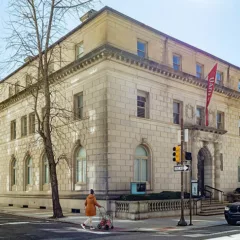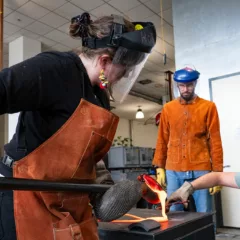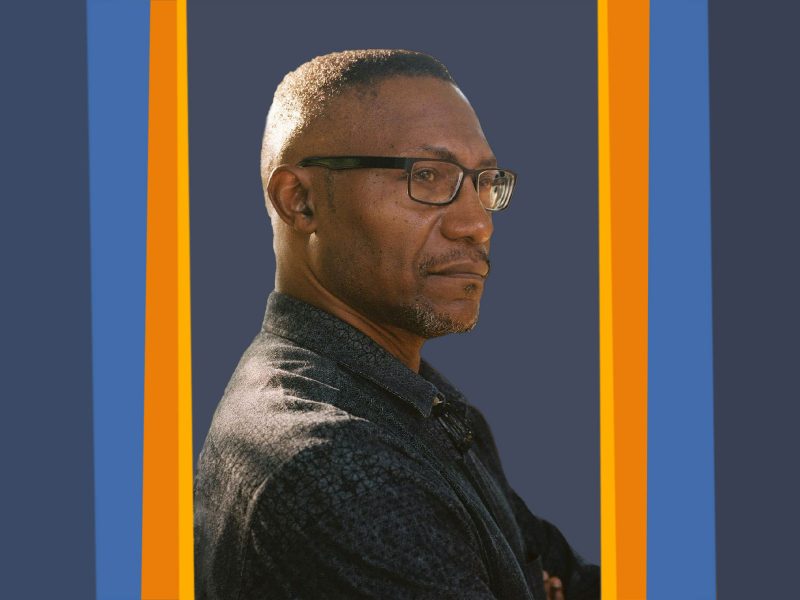
Eric Battle is an illustrator, curator and art director, who has worked on comics, novels, children’s books and fashion illustration. His recent book project, “BLAM!” Black Lives Always Mattered, is a terrific graphic novelization of 14 Black Philadelphians. Illustrated (by Battle and notable local artists, Jamar Nicholas, Nile Livingston and others), the book treats some well-known Philly “Hidden Heroes” like W.E.B DuBois and Marian Anderson, and others who are less familiar, like Frederick Massiah, Crystal Bird Fauset and Ruth Wright Hayre.
More information on the book here. More on Eric Battle here. Eric Battle on Instagram
You can listen to Artblog Radio on Apple Podcasts and Spotify. Thank you to Kyle McKay for composing Artblog Radio’s original podcast intro and outro!
Photos
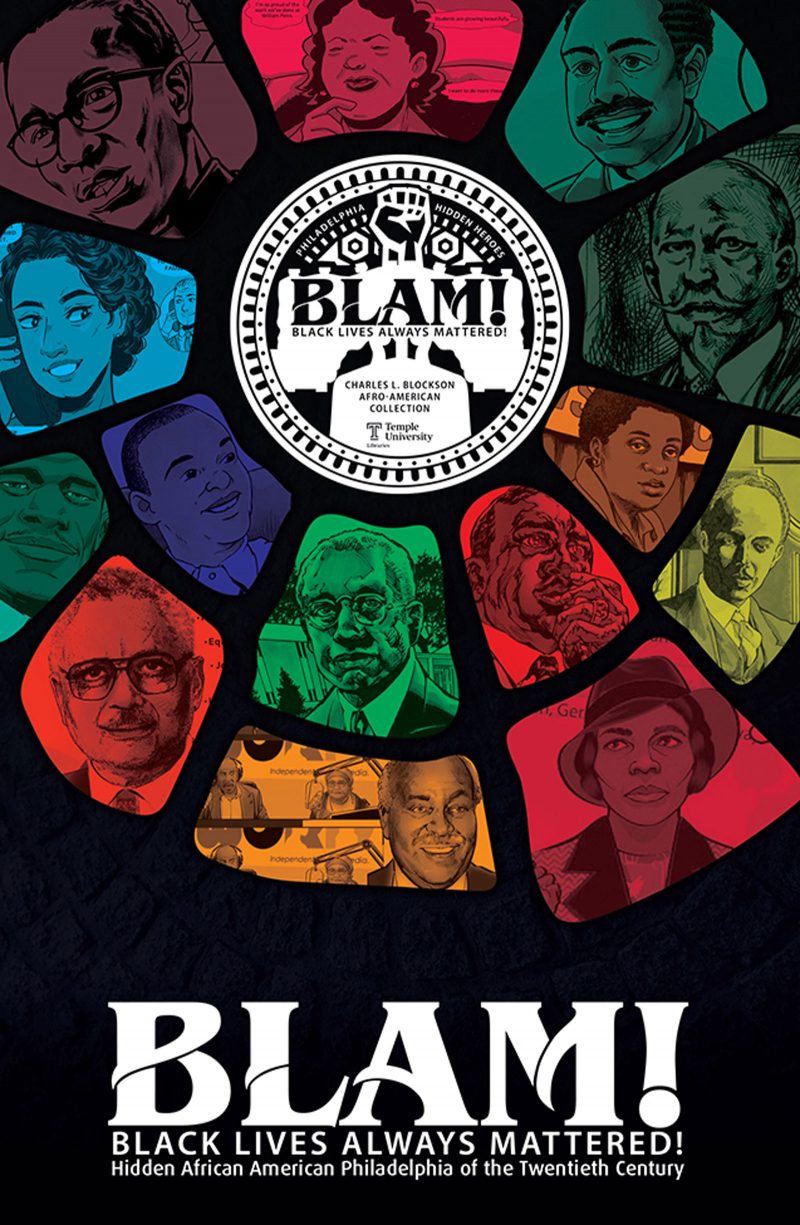
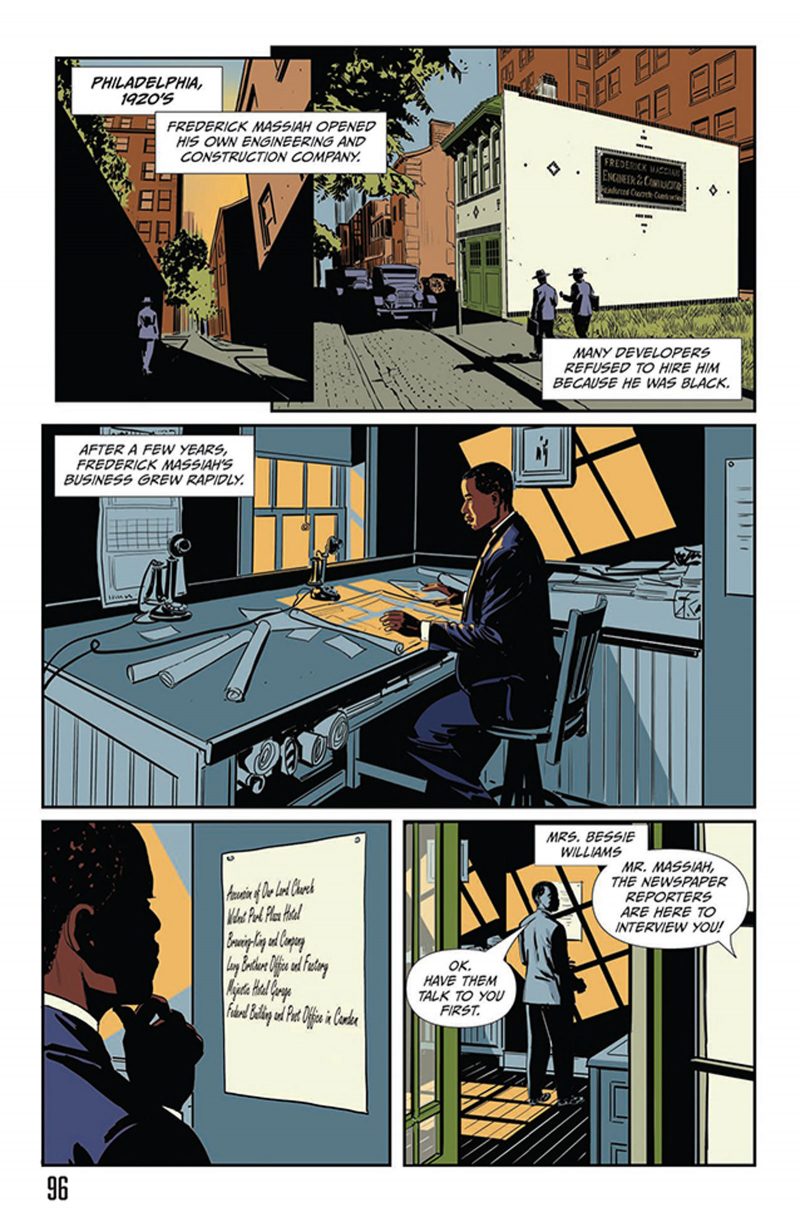
Transcription
[00:00:00] Roberta Fallon: Hi everyone. It’s Roberta! Welcome to another episode of Artblog Radio. Thanks for joining us today. I am really excited to speak with our guests today, Eric Battle. Welcome Eric!
[00:00:25] Eric Battle: Good morning. How are are you?
[00:00:26] Roberta: I’m great. How are you?
[00:00:29] Eric Battle: am well.
[00:00:30] Roberta: Good. Thanks for being here. Let me introduce you to everyone. Eric Battle is an artist, illustrator, curator, and art director, who has worked on comics, novels, children’s books and fashion illustration among other things. I’m speaking with Eric today, because I want to hear more about his recent book project, “BLAM!…” (That’s B-L-A-M exclamation mark, all capital letters,) “…: Black Lives Always Mattered.” And first I want to say yes, yes, yes, period.
So congratulations on this book, it’s a marvelous graphic novel about 14 important Philadelphia African-Americans of the 20th century. And Eric you’re the Art Director, and also one of the artists that illustrated some of the stories.
So let’s get started with the questions because there’s a lot to talk about here.
[00:01:26] Eric Battle: All right.
[00:01:27] Roberta: BLAM! Is beautiful. It’s a totally beautiful, gorgeous, colorful, bold book, 164 pages, large overscale book with a hard cover, very smart design. And it seems to be, when I was looking at it, part encyclopedia of the 14 individuals, and part graphic storytelling, and they go together, which I want to talk about. That’s a really interesting way to sort of design a book.
But most of All it’s a book about heroes, right?
[00:02:00] Eric Battle: Yes, absolutely.
[00:02:02] Roberta: And some are pretty well known and some are less well known. Well, to me… you know, I’m sorry, I know what I know, but it was wonderful to have my eyes opened by this book.
So can you begin by telling us a little bit about the 14 individuals in the book?
[00:02:20] Eric Battle: Yes. Well, the goal of the book is to inform people in an engaging manner about individuals that they may or may not have known about prior to reading the book. And in terms of the format of the book, you know, I wanted it to be more than a graphic novel and more than a textbook. Because the goal of the book, primarily, is to go out to schools. Philadelphia schools, like grade schools and high schools. We needed the book to be sturdy because it’s going to be handled by students.
But yeah, that, that was the primary goal of the construction and the design of the book, but the 14 individuals that, that are being profiled in the book, again, there are, there are some more well-known individuals like W.E.B Du Bois, Marian Anderson, Cecil B. Moore, individuals like that. And then you’ve got Alain Locke, Frederick Messiah, Crystal Bird Fauset, Dr. Ruth Hayre, Reverend Leon Sullivan…
So again, you know, it’s, you know, wanting to wanting to present the information in an entertaining manner, something that, that people will get easily engaged with. Especially for students being able to like match the information with compelling visuals, that always helps draw people in and receive the information well.
[00:03:53] Roberta: Yeah, I thought that was… That’s a great introduction to the book, and thank you for explaining all that. I think you’re emphasizing that you wanted it to be more than a graphic novel and not quite a textbook, is a perfect marriage of what you wanted. It worked out well.
I wanted to talk to you about how you split the information. We should explain, each person’s section involves a large spread of six to eight pages of graphic design novelization, and then preceded by two, a two page spread of, what I thought was more textbook-like, or encyclopedic. So just photographs of the person with birth date, death date, that sort of thing, and what their accomplishments were.
It was interesting to me what was in those two page textual spreads, and what was not, and what showed up in the graphic novelization. So was there like a planned way to divide the text and figure out what went where?
[00:05:05] Eric Battle: Yes. So, all of the information was compiled by Dr. Diane Turner and Aslaku Berhanu. They’re the the archivists and the, um… Oh, my goodness. I’m blanking.. (laughs) the historians over at Temple University’s Charles L. Blockson Library. So they compiled all of the information and they decided… They put lists together of who was going to be profiled, and what information was going to be in the I guess like text pages, and what information was going to go into the sequential art pages.
And again, you know, since we had limited page counts for each individual you know, we weren’t, we weren’t looking to tell everyone’s complete life story.
So we just had to basically pick out certain aspects of their careers and experiences that primarily led to them being known as the dynamic individuals that they were. So you know, just kind of like highlighting specific elements of their life’s experiences.
[00:06:16] Roberta: So, I guess we should talk about where the source material came from.
[00:06:21] Eric Battle: Yes.
Yes. So Dr. Turner, she’s the, she’s the head Historian over at Temple’s Blockson Library. So like I said, she compiled all of the information. So like the Blockson Library, you know, they’re, they’re like a repository for, you know, African-American literature, culture arts, you know, everything, so… Putting together the list of people, you know, again, we only covered 14 people in this particular volume. Like whittling the list down to just 14 was pretty tough. But, you know, we wanted to make sure that we were covering a large, at least as large a span as we could of, politics, arts and culture, activism, things like that.
Dr. Turner and Aslaku they, again, they decided on who, who would be profiled in this particular volume. So hopefully, this will be the first of many more. Because again, there’s so many people that we, we could cover and we can cover going forward, so…
[00:07:31] Roberta: is this breaking news. Are you breaking news here? That there may be a follow-up book.
[00:07:36] Eric Battle: Well that’s, to me, that’s the hope, you know? Cause I think, I think when, you know, when people see this Again, this is, this is just a start. So my hope is that when we get it to, as, you know, as many people as possible that people will want more. And I hope that this will be the first of many more.
[00:07:55] Roberta: I hope so, too, frankly. (laughs) Let’s get to talk about the illustrators because this is an arts blog, right? And we love art, and graphic novelizations are just one of my sweet spots when I talk about art. So. Who were the, some of the illustrators. And where did they come from? Are they all Philadelphia artists and illustrators?
And are they in your network? Did you reach out, was there an open call? What happened.
[00:08:27] Eric Battle: So Most of the illustrators I’ve known and admired and had the pleasure of either working with prior to this or, you know, we’ve been friends for years. Most of them are from Philadelphia or, or have a connection to Philadelphia.
The only two that aren’t here in Philadelphia, well, there, there are three who aren’t from Philadelphia, that’s Micheline Hess, she’s in New York and Will Rosado, he’s also in New York. But both of them, I’ve known them for years and I’ve always admired their work and their work ethic. Primarily most of the illustrators and I had worked with prior to this on another graphic novel that I did for the um, Philadelphia Jazz Project.
So from that project I reached out to a handful of those artists Akinseye Brown, Nile Livingston, Nancy Devard, Mike Leeke, and Jamar, Nicholas, they’re all here in Philadelphia. So all of the artists that were selected for this particular project, I knew that I could count on just in (laughs) just in terms of like being professional and meeting deadlines. But again, primarily it’s like, I love their work and this project. Gave me the opportunity to connect with, with fellow artists. And again, you know, just being able to collaborate with them and seeing, seeing the kind of creations that they’ve, they’ve come up with to tell these stories was, you know, just, just, essential to me.
And because everyone has a specific, their own individual style, it gave each profile its own look. And that’s, that was another goal of, of the book and, giving each individual who is who’s being profiled, their own visual voice. So that was, that was part of the uh, the goal also.
[00:10:27] Roberta: That’s great. So yeah, one of my questions is the color changes from story to story. There are some that are black and white, some that are full color. And Nile Livingston– pastel! This surprising pastel color palette!
So did they get to select? And also the number of pages did that get worked out sort of back and forth between you and them and the material? Or how did that work? I just am curious here.
[00:10:59] Eric Battle: Yes. So again like the page counts for each each profiles, those were, those were like really kind of outlined by the information that we received from Dr. Turner. We had about like six to eight pages per profile.
So in terms of how each artist went about their work, again, they’re all professionals. I’m not the kind of person who wants to like, dictate everything about what they’re doing, because again, I trust them and I told them just like, do what you do, you know?
in terms of like Nile Livingston and Nancy Devard, I think this may have been their first forays into sequential artwork, like comic book type storytelling, and that excited me, just the idea that…
Nancy Devard, I’ve known her over the years. She primarily does like children’s books and greeting cards. But before she and I got started on this, just me envisioning what she could do with sequential art, I was just like, okay, I’ve got to have her.
And I specifically wanted her to do Marian Anderson’s profile because I just knew that she would give it all of the glow and majesty that Marian Anderson deserves. And, you know, it’s like every panel and page that she turned in is just a work of art, so…
When all of the art was coming in from each artist, it was… matter what else was happening around me, when the artwork was coming in, it just like really just excited me all the more just for this project.
And honestly, like everything, everything couldn’t have worked out any better than it has. Like the work that Nile’s done, like, because she’s not, she wasn’t familiar, or she wasn’t constrained by the, I guess the typical comic book style of working, like her, the ways that she used color blocks to, to move the reader’s eyes around her pages… to me, that’s just brilliant stuff.
So again, and, you know, just having the mix. And variety of, of styles. Again, it just, it just really could not have worked out any, any better than it than it has.
[00:13:30] Roberta: That’s so great to hear. I really was struck by Nile’s pages because unlike the traditional, like you said, they didn’t have much experience with the traditional comics making. There were no boxed off things, things flowed, there was a really direct free flow. And then there was one page that was a compelling, just a full figure with little words around kind of almost like those radiating lines, except that it was words around the figure of… Leon Sullivan, it was.
So, truly eye opening in terms of graphic display. Yeah.
[00:14:17] Eric Battle: And you know, so like with, with artists, Dwayne Turner, now I’ve known him for years. And to me he’s like, he’s a hero of mine. So to have him working, you know, have, have him like create original artwork for this book was just to me, that was like, you know, that was a win right there. Because he’s, he’s worked in comic books for years and before I knew him, I knew of his work, so you know, reaching out, you know, when I reached out to him to ask him if he, if he’d want to do this. Cause he had, he had left comic books, a couple, a good number of years ago, and he’s been doing storyboards for movies. So he, he did, he recently did the storyboards for the, the knew Spider-Man movie that’s out, “Spider-Man: No Way Home” and…
So he’s, you know, he’s been in California and Hollywood, you know, doing just like fantastic things. But I was so honored that he that he agreed to, you know, contribute artwork to this particular project.
Um, So that we’ve got a, we’ve got a vast variety of… of like, veterans in the industry and uh, a couple of newcomers, you know, younger artists in the book. We’ve got Dylan Caleho and the Damali Beatty. So they’re, they’re probably the youngest artists on the book.
And Dylan, I, she and I had worked, she did a uh, some artwork for me on the Philadelphia Jazz Project book also, so, and again, I, you know, I just love her. I love her style. I love her work. And again, her work ethic.
Damali Beatty, I’ve known her. I’ve actually, I’ve known her. I’ve known her since she was a baby. And because her, her father, her parents, and I have, you know, we’ve known each other for years, but, and she had recently graduated from University of the Arts. And her senior project, she had created, she had written, and drawn, and produced her own graphic novel. So I was like, Hey, you know, she’s, she’s got what it takes to do this.
[00:16:26] Roberta: That’s terrific.
[00:16:28] Eric Battle: Yes,
[00:16:29] Roberta: That’s great. That’s the next generation, right? You want to get them when they’re young, and work with them. That’s really great. Great, great, great. Let’s talk about distribution of the book. I know you said elementary schools, secondary schools. Are there any copies of this book envisioned for the general public or are they outside the mission of who this book is for?
[00:16:55] Eric Battle: Well, so the primary mission at first was to, for the books to be distributed, again, throughout like grade schools and high schools. So a bulk of the books are going, going out to schools. So we, I think we had about 7,000 printed. So about 5,000 of those books are going out to schools.
We are going to make some number of books available to the public. So, you know, because it was a grant funded project through Pew, you know, we were still like work, trying to work out some of those logistics. But I’m working on some other opportunities to, to get a printing done that we can have go out to the, the general public and, you know, Hopefully have on like, you know, Amazon and those sorts of things.
Just, just, again, just make it more widely available because again, like right now it’s primarily getting them to the schools, but… The type of book that it is like, because it’s a graphic novel, you know, comic book enthusiasts will want copies, historians and, you know just book lovers will want it, also, other educators would love it so, you know, we’re hoping to get them, get them into like museums, other cultural institutions, and things like that, so.
Fingers crossed that that’ll all work out. So… (laughs)
[00:18:22] Roberta: (laughs) I hope so too! I think there’s going to be a very wide adult audience for this as well as your students. I think the students are going to be blown away. How are they in the hands of the students yet? Where they distributed yet? And have you gotten feedback?
[00:18:37] Eric Battle: No, they haven’t been distributed yet because we got them, we got them in later than we thought, but I think probably like going into the new year. I, you know, I know that the, the list of schools, I know that’s all been compiled and everything. And I think at this point is it’s basically in the hands of the school district to like disseminate the… you know, distribute the books out to the, the select schools.
But yeah, I’m excited to see what the feedback is.
[00:19:09] Roberta: Totally.
[00:19:10] Eric Battle: And you know, my thing is like if I were a student and I saw this book, I, (laughing) you know, I… I hope each school has a way to.. I don’t know if they’re going to like, let students check them out or borrow them? But I hope they have a way to get them back, (laughs) you know?
Because again, it’s, it’s such a, it’s such a unique looking book. You know, I, again, I’m very very excited to see, you know, how, how people react to it and uh, You know, what, what feedback is from it.
[00:19:49] Roberta: Well, I hope it is distributed with a big fanfare. Which it deserves, you know, like with panels with you and Dr. Turner and everybody else speaking at the schools about the project. I think that might be very exciting for the students to hear how it came to life and then to actually see the book.
[00:20:11] Eric Battle: Yeah. And I know, I know Dr. Turner has a, she’s got a plan of holding like events at, schools and things like that, so. Again, you know, with, with everything that’s going on, I, you know, I hope that all comes to comes to be. So.
[00:20:28] Roberta: Me too. Well uh, to be continued in 2022, I think.
[00:20:33] Eric Battle: (laughs) Absolutely.
[00:20:35] Roberta: Let’s talk about how you became involved in graphic novels. How did you become a sort of comics maker, a graphic artist.
[00:20:51] Eric Battle: Well it really all started when, like when I was a kid, you know, I can see it in my head, like as clear as day, just like going to the, one of the corner stores with my mother one day and there was a a comics rack. It’s called a spinner rack in the store. And I remember running over to it and, you know, like looking at all the comic books that were on the rack and just, just really being mesmerized by the, by the images that I saw, you know? The colors, the costumes, the dynamics that were, that were drawn on the page. And so again, that’s, that’s really where it started and, you know, my mother, she bought me a couple of comic books and I just became just like really obsessed with it all. You know, just starting to uh, you know, first starting to try to copy the images that I saw.
But I got bored with that pretty quickly. And I was like, okay, well, you know, just trying to like, dissect how, how these things were made. So, you know, it’s like I wanted to, I started to try to, you know, make up my own characters. Figuring out how to make the, how to make my drawings, the figures look as dynamic as the figures that I saw on the page.
So then, you know, my mother, she noticed that I was pretty I guess, focused on drawing. So, you know, she enrolled me in a couple of classes with different organizations around the city. And you know, she really, she just really helped foster my, my enthusiasm for artwork. So like to me, like a blank, you know, piece of paper was… That was everything, you know? So just really went from there.
I went to Overbrook high school. I was part of their uh, what we call art magnet program there. And then from, from Overbrook, I went to University of the Arts. It was still a Philadelphia College of Art when I first got there. Then I think during my last year there, they switched over to university status. When I got to college, I figured I wanted to… I kind of wanted to step away from comic books because I was like, “oh, I wanted to paint.” I envisioned like painting covers for like national geographic and you know, a lot of the other magazines that were still using a lot of illustration.
But in the course of being in college, seeing that comic books… to do comic books, you really have to know how to draw any and everything. And honestly, it kinda gave me a, an advantage in terms of like, being able to just put all kinds of scenarios together on a page. So I was like, I can incorporate graphic design. I can incorporate fashion design. I can incorporate, you know architecture all in one medium.
So I was like, “okay, well, I think I’m going to stick with this.” (laughs) And after graduating, you know, it was just about putting together my portfolio. And wanting to, well needing to put together different types of portfolios, because I still wanted to do like other types of illustration, like advertising illustration and, and fashion design and things like that, you know, I had done some children’s books stuff where, you know, again, I was painting, and doing other types of illustrations, but… I guess it was still gravitating towards comic book artwork.
And with that I remember like going to different like conventions just showing the editors, you know, What I could do in terms of like sequential artwork and things like that. And, you know, I’ve, worked with Marvel, I’ve worked with DC comics and most of the major comic book publishers.
But within the past couple of years, past number of years, I’ve been able to kind of carve out work for myself, working with like, respected authors. I’ve worked with Nnedi Okorafor who’s you know, multi award winning science fiction and fantasy author. Philadelphia native L. A. Banks, She, uh, she passed in 2011, but she, she was writing a vampire hunters novel series. And I met her at a bookie fit that was at the Franklin Institute. And I approached her about putting visuals to her work and that just, you know, that relationship just like sparked from there. And it, you know, we were just able to like really create some, some wonderful work together.
You know, it’s like, thankfully I’ve been able to kind of like navigate where, where I’ve been able to take my work, and… At this point kind of carve out an area for myself where I can do work that speaks to me and that I, you know, that I can, that I have more, I guess control over, you know? And it, it is nice to be able to like, have a choice in, in the type of work that, that you can do.
[00:26:01] Roberta: Absolutely. You know, one thing they don’t really teach you in art school, but you are a demonstration of how this can work for artists? Is… You’re an entrepreneur. Artists are basically small business owners. They are entrepreneurs and they’re constantly hustling and seeing opportunities where maybe others would not see opportunities.
And I just love the way you told your story here about approaching people like. LA bank about their vampire hunters series and visualizing it. I that’s just brilliant. That’s what artists do. It’s it’s a really great example.
We’re going to have to wrap it up here, Eric. I’m so sorry. I feel like we could go on for another half an hour here, but this has been a fabulous discussion of “BLAM!”
And is there anything you want to mention before we sign off?
[00:26:59] Eric Battle: Well, again, I, you know, I just, I just really hope that people receive the book well and you know, I’m looking forward to, to seeing, you know, to like hopefully guiding the way we can. Get the book into, as many hands as possible in, in this upcoming new year.
[00:27:17] Roberta: Excellent.
[00:27:18] Eric Battle: And, and, again, you know, I want to thank, thank you for having me here. it was a pleasure being able to get a copy to you, and… again, again, just thank you.
[00:27:29] Roberta: Thank you. And we should do a shout out to Betty Leacraft, who, you know, has been a mentor to you, is one of my dear friends, and it was through Betty that I met you at Richard Watson’s show at the African American Museum and you generously gave me one of the last copies of the book that you had. I was so blown away by your generosity.
So thank you. Thank you so much. And thanks for speaking with me and. Everyone I’m signing off now, I’ve been speaking with Eric Battle. Eric, thank you so very much for making the book “BLAM!” Be such a beautiful, gorgeous book as Art Director and illustrator of some of the stories. And I look forward to seeing more work by you in the future.
[00:28:19] Eric Battle: Again, thank you for having me
[00:28:20] Roberta: You’re welcome. Thank you. Thanks everybody. Have a good…. day.
[00:28:26] Eric Battle: (laughs) Excellent.
[00:28:29] Roberta: Bye. Bye.
[00:28:30] Eric Battle: Take care now.



